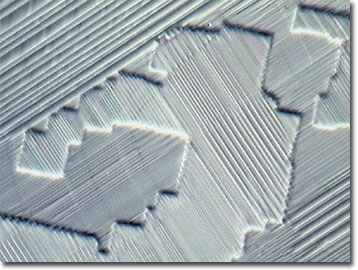Oblique Digital Image Gallery
Lanthanum Aluminate Twinning
Lanthanum aluminate is a member of the perovskite class of ceramics, many of which are able to superconduct at liquid nitrogen temperatures. Perovskites are often characterized by large covalently bonded, closely packed cubic structures that have an atom with a significantly smaller atomic radius located at the center. When electrical fields are applied to perovskites, the smaller, central atom can shift within the crystal lattice without breaking bonds. Although not a superconductor itself, lanthanum aluminate is well adapted as an epitaxial substrate for growing thin films of related superconducting ceramics.

View a medium magnification image of twinning in lanthanum aluminate.
View a high magnification image of twinning in lanthanum aluminate.
Techniques for growing perovskite thin films on lanthanum aluminate substrates include metal oxide chemical vapor deposition (MOCVD) and molecular beam epitaxy (MBE). Buckminsterfullerenes, nicknamed buckyballs, are 60-carbon alkenes that are very rugged superconductors. Capable of superconducting at relatively high temperatures, buckyballs can be grown as thin films on lanthanum aluminate substrates.
Crystals of lanthanum aluminate are rarely formed perfectly on the Earth. Stair-step twinning, a type of crystal flaw, interferes with the formation of confluent deposited thin-films. This is significant since superconductors built on imperfect surfaces cannot handle higher levels of electric current and do not perform predictably.
Lanthanum is an element from the rare earth series. As a combination of lanthanum, aluminum, and oxygen, lanthanum aluminate forms imperfect single crystals if cooled too quickly from the high temperatures of annealed crystallite formation. When this occurs, the molecules do not have sufficient time to settle into their most "comfortable" arrangement (or a perfect crystal), and the flaw becomes permanently locked into the structure. Similarly, gravity interferes with perfect lanthanum aluminate crystallization. Crystallographers are turning to outer space for growing lanthanum aluminate crystals devoid of twinning. Gravity-free experiments on the space shuttle missions and the space laboratories could be promising for creating the next generation of superconducting materials and futuristic applications such as magnetic-levitating (mag-lev) trains.
Contributing Authors
Cynthia D. Kelly, Thomas J. Fellers and Michael W. Davidson - National High Magnetic Field Laboratory, 1800 East Paul Dirac Dr., The Florida State University, Tallahassee, Florida, 32310.
BACK TO THE OBLIQUE IMAGE GALLERY
BACK TO THE DIGITAL IMAGE GALLERIES
Questions or comments? Send us an email.
© 1995-2025 by Michael W. Davidson and The Florida State University. All Rights Reserved. No images, graphics, software, scripts, or applets may be reproduced or used in any manner without permission from the copyright holders. Use of this website means you agree to all of the Legal Terms and Conditions set forth by the owners.
This website is maintained by our
Graphics & Web Programming Team
in collaboration with Optical Microscopy at the
National High Magnetic Field Laboratory.
Last Modification Friday, Nov 13, 2015 at 01:19 PM
Access Count Since September 17, 2002: 13170
Visit the website of our partner in introductory microscopy education:
|
|
